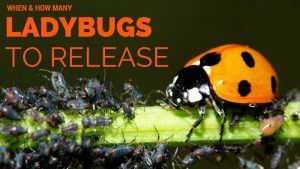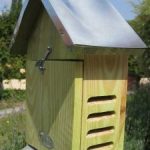by Ken Lain, the mountain garden

The aphids are thick in the garden. Lisa and I were enjoying a sunset this week and the winged adults were so thick they were drawn to the flames of the firepit and polluted our iced teas. Time to bring some ladybugs from the garden center. We have ladybugs at the garden center or you can buy them online from Amazon.
There are many reasons to love Ladybugs. This little red beetle started as a legend during the middle ages. European farmers, about 1000AD, struggles with insects that would eat and destroy their crops. At the first sign of crop damage, farmers would pray to the Virgin Mary for help. Ladybugs came and ate the harmful insects and the farmers named these answers to prayer as “Our Lady’s beetles”; this eventually became ladybugs. Since the 1800’s farmers have been raising ladybugs domestically to control pests on their organic farms.
Today, you can buy ladybugs to release in your own garden and help control unwanted pests. Many people who  prefer not to use chemicals in their garden look for organic methods to keep their gardens healthy with ladybugs gaining popularity as an all natural control.
prefer not to use chemicals in their garden look for organic methods to keep their gardens healthy with ladybugs gaining popularity as an all natural control.
Ladybugs are most active during the warm days of spring and well into fall. They primarily eat aphids but also prey on scale, mealybugs, spider mites and thrip. They are ferocious eaters – eating as many as 5,000 aphids in their lifetime.
There are over 500 species of ladybugs in the United States alone, and over 4500 in the world. The ladybug we recommend here at Watters Garden Center is the species Hippodamia convergens. You can recognize this particular ladybug by the two white dashes on the back of its body, and Watters carries these ladybugs starting in March through the spring season.
How to Release Ladybugs in the Garden
Keep the Cool – The cool weather mid-week has been perfect for releasing ladybugs in the garden. Ladybugs have wings and like to use them. You will need to slow them down long enough to find your gardens attractive. When you get home with your ladybugs, leave the cup sealed and place them in the refrigerator or cool space (35-40 degrees). Being cool calms ladybugs down. Keep them refrigerated until you’re ready to release them that evening.
Ladybugs will be thirsty at first. Spray or mist the parts of the garden you plan to release your ladybugs in. This will allow them to rehydrate before searching for a meal. You will not have to do this again as ladybugs get most their moisture from the insects they feed on.
Release them at night – plan to release ladybugs in your garden at the base of a plant just as dusk arrives in the evening. If you have a plant with a particular aphid problem open the cup at the base of that plant. This will give them the night to settle in, find food and realize that your garden is a great place to live!
Grandfathers only! Get your kids involved! Plan ahead and allow your granddaughters to dress up as  ladybugs before releasing actual ladybugs into the garden. I guarantee this is a memory your daughters will not forget. I find the mask even works for sons under 6 years old. Here’s an inexpensive outfit found on Amazon. Kids especially have fun releasing ladybugs and this is a great way to teach them about environmental responsibility. You will find ladybugs stick around and kids will find them all season long. Stop in and pick up a cup of ladybugs, take them home and have fun enjoying nature this spring.
ladybugs before releasing actual ladybugs into the garden. I guarantee this is a memory your daughters will not forget. I find the mask even works for sons under 6 years old. Here’s an inexpensive outfit found on Amazon. Kids especially have fun releasing ladybugs and this is a great way to teach them about environmental responsibility. You will find ladybugs stick around and kids will find them all season long. Stop in and pick up a cup of ladybugs, take them home and have fun enjoying nature this spring.
A Ladybug house gives these decorative beauties a place to rest from the elements, especially through winter. Encourage Ladybugs to stay near your garden the season.
Fresh ladybugs just arrived at Watters Garden Center, I’ll be helping customers at the bug counter until next week’s issue.
Free gardening classes:
April 14 @ 9:30 am Garden Advice that Works in the Mountains – Ready to start your garden but want a little extra help? This class will take an in-depth look at how to be successful when planting your garden paradise. We’ll discuss techniques for brighter, more beautiful gardens, and how to keep them healthy. Learn how to troubleshoot and combat problems like poor soil conditions, pests, and diseases that can frustrate any gardener whether a master or a novice. Bring your notepad!
Open this link to see all of Watters garden classes this spring.
Ken Lain can be found throughout the week at Watters Garden Center, 1815 W. Iron Springs Rd in Prescott, or contacted through his web site at WattersGardenCenter.com or FB.com/WattersGardenCenter .

